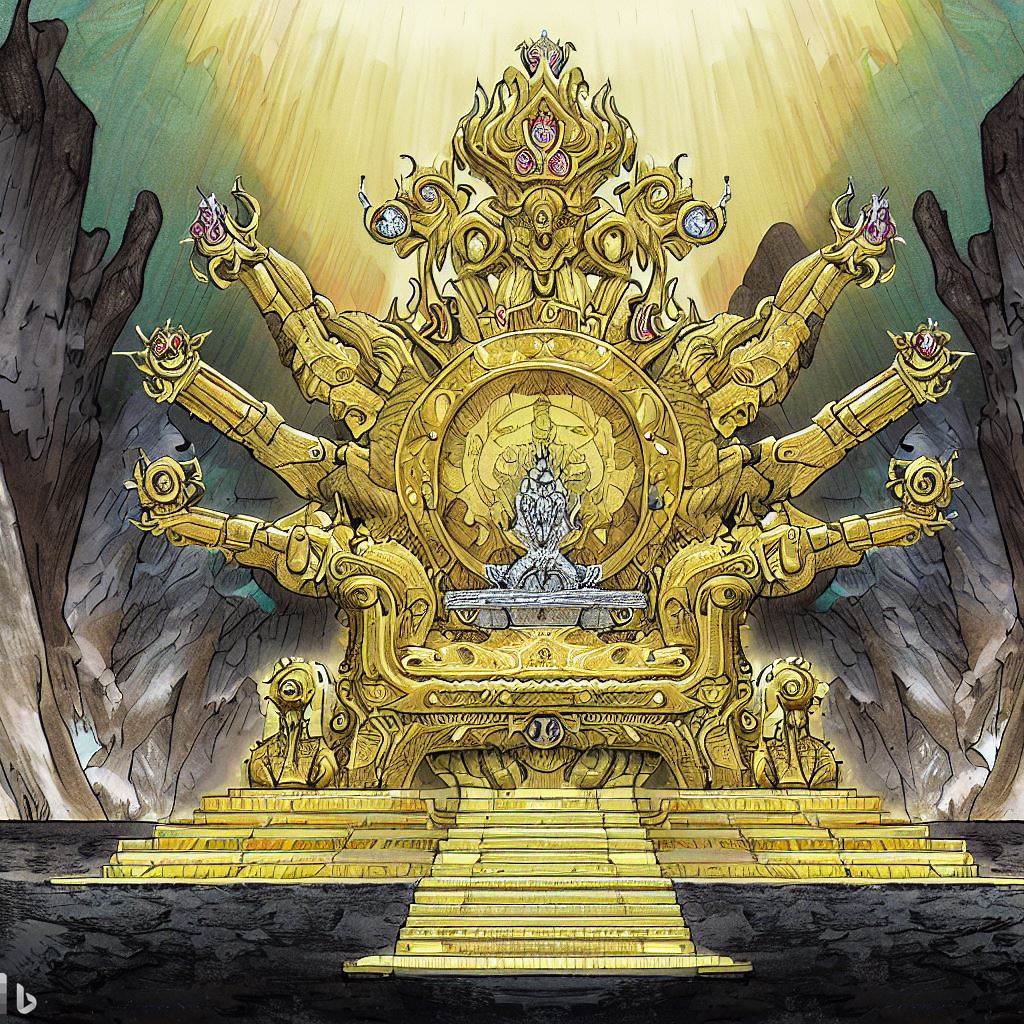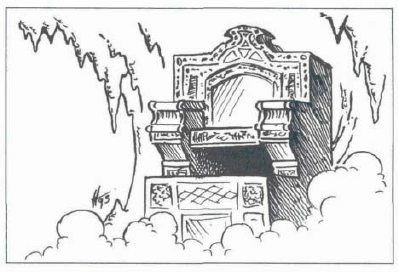BOOK OF ARTIFACTS
The Throne of the Gods: A Legendary Artifact for AD&D
If you are looking for a way to spice up your AD&D campaign, you might want to consider using the Throne of the Gods, a powerful and mysterious artifact that can grant any wish or destroy any plane. In this article, we will tell you everything you need to know about the Throne of the Gods, including its origin, purpose, effects, and how to use it in your adventure.
What is the Throne of the Gods?

The Throne of the Gods is an artifact that was created by the gods themselves to serve as a meeting place and a symbol of their authority. It is described in detail in the Book of Artifacts, a sourcebook for the AD&D 2nd edition game1. The Throne of the Gods is located on a floating island in the Astral Plane, surrounded by a ring of 12 smaller islands that represent the 12 major pantheons of the multiverse. The Throne itself is a massive structure made of gold, silver, and precious gems, with a seat for each god and goddess. The Throne can grant any wish to those who sit on it, but only if they have the approval of all the other deities present. The Throne also has the power to create or destroy any plane of existence, alter the laws of reality, and reshape the multiverse according to the will of the gods2.
The Throne of the Gods is one of the most sought-after artifacts in the AD&D game, as it can offer unparalleled power and influence to those who can access it. However, reaching the Throne is not an easy task, as it requires traveling through the dangerous Astral Plane, avoiding or defeating the guardians and rivals that patrol the area, and convincing or tricking the gods to let them sit on the Throne. Many adventurers have tried to find and claim the Throne of the Gods, but few have succeeded, and many have paid a terrible price for their hubris3.
Why should you use the Throne of the Gods in your adventure?
The Throne of the Gods is an artifact that can add a lot of excitement and drama to your adventure. It can be used as a plot device, a reward, a challenge, or a twist. Here are some reasons why you should use it in your adventure:
- It can create a compelling goal for your players. The Throne of the Gods is something that many characters would want to find and use, either for good or evil purposes. You can use it as a motivation for your players to embark on a quest, or as a reward for completing one.
- It can create a lot of conflict and tension. The Throne of the Gods is something that many factions would want to control or destroy, either for religious or political reasons. You can use it as a source of conflict between your players and their enemies, or even among your players themselves.
- It can create a lot of surprises and twists. The Throne of Gods is unpredictable and capricious, and it can grant or ruin one’s wishes depending on the character’s thoughts and and the gods’ whims. You can use it as a way to introduce unexpected outcomes, complications, or revelations to your adventure.
How to write an adventure that involves the Throne of Gods?
Writing an adventure that involves the Throne of Gods can be a rewarding and challenging experience. You need to consider several factors, such as the setting, the plot, the characters, and the rules. Here are some steps you can follow to write an adventure that involves the Throne of Gods:
- Step 1: Choose a setting. The setting is the location and time period where your adventure takes place. You need to choose a setting that is suitable for your adventure’s theme, tone, and level. For example, if you want to write an epic and high-level adventure, you might choose a setting that is rich in history, culture, and magic, such as the Forgotten Realms or Greyhawk. If you want to write a dark and low-level adventure, you might choose a setting that is grim, gritty, and dangerous, such as Ravenloft or Dark Sun.
- Step 2: Choose a plot. The plot is the main storyline and goal of your adventure. You need to choose a plot that is engaging, coherent, and relevant for your adventure’s setting and characters. For example, if you want to write an adventure that involves the Throne of Gods, you might choose a plot that revolves around finding, reaching, or using the Throne of Gods for some reason. You might also choose a plot that involves competing or cooperating with other factions that are interested in the Throne of Gods.
- Step 3: Choose the characters. The characters are the people who participate in your adventure, either as protagonists or antagonists. You need to choose the characters that are appropriate for your adventure’s setting, plot, and level. For example, if you want to write an adventure that involves the Throne of Gods, you might choose the characters that are related to the gods, such as clerics, paladins, or cultists. You might also choose the characters that are motivated by curiosity, greed, or ambition, such as explorers, thieves, or mages.
- Step 4: Choose the rules. The rules are the game mechanics and guidelines that govern your adventure’s actions and outcomes. You need to choose the rules that are consistent with your adventure’s setting, plot, and characters. For example, if you want to write an adventure that involves the Throne of Gods, you might choose the rules that are detailed in the Book of Artifacts, such as how to find, access, and use the Throne of Gods. You might also choose the rules that are specific to your setting or edition of AD&D, such as how to travel through the Astral Plane or how to handle divine intervention.
- Step 5: Write your adventure. The final step is to write your adventure using your chosen setting, plot, characters, and rules. You can use the following structure to organize your adventure:
- Introduction. This is where you introduce your adventure’s setting, plot, and characters. You should also provide some background information, hooks, and goals for your players.
- Scenes. These are the main events and encounters of your adventure. You should describe the locations, challenges, rewards, and consequences of each scene. You should also provide some options and branches for your players to choose from.
- Conclusion. This is where you wrap up your adventure’s plot and characters. You should also provide some outcomes, rewards, and consequences for your players based on their actions and choices.
Conclusion
The Throne of Gods is a legendary artifact for AD&D that can make your adventure more fun and memorable. It can create a compelling goal, a lot of conflict and tension, and a lot of surprises and twists for your players. It can also challenge your creativity and imagination as a DM or a player. If you want to use the Throne of Gods in your adventure, you can follow these steps:
- Choose a setting that suits your theme, tone, and level.
- Choose a plot that revolves around finding, reaching, or using the Throne of Gods for some reason.
- Choose the characters that are related to or interested in the Throne of Gods.
- Choose the rules that govern how to find, access, and use the Throne of Gods.
- Write your adventure using an introduction, scenes, and a conclusion.
The Curse of the Throne of the Gods
The Throne of the Gods is not only a source of great power, but also of great peril. The gods are offended when mere mortals use their sacred seat, even if they have humble intentions. The Throne can grant or ruin one’s wishes depending on the character’s thoughts and the gods’ whims. The Throne can also invoke a curse upon those who sit on it or attempt to do so.
The curse of the Throne of the Gods can take many forms, such as:
- A cursed item that appears to be the desired one, but has negative effects or malfunctions.
- A reduction of one’s prime attributes or experience levels.
- A teleportation to a random and dangerous location or plane.
- A transformation into a babbling idiot or a monstrous creature.
- A confrontation with a random god or goddess on their home plane.
The curse of the Throne of the Gods is not easily removed or avoided. It can only be lifted by the gods themselves, or by a powerful magic that can counteract their will. The curse can also affect those who are near the Throne, or those who are involved in its quest. The curse can also be contagious, spreading to others who come in contact with the cursed ones.
The curse of the Throne of the Gods is a serious threat that should not be taken lightly. It is a test of one’s faith, wisdom, and courage. It is a challenge that can make or break one’s destiny. It is a price that must be paid for seeking the ultimate power.
The Price of Power: Three Risky and Complicated Ways to Destroy the Throne of the Gods
The Throne of the Gods is a legendary artifact that can grant any wish or destroy any plane, but it is also very difficult to destroy. According to the web search results, there are some suggested means to destroy the Throne of the Gods, such as:
- Forcing any major power, under pain of death, to unmake the Throne. This could be a god, a demon lord, an archdevil, or a primordial. However, this would require finding and capturing such a being, and convincing or coercing them to use their power against the Throne. This could also have dire consequences for the balance of the multiverse, as well as the wrath of the other powers.
- Wishing it had never been built 1,000 times. This could be done by using the wish spell, or by sitting on the Throne itself and wishing for its own nonexistence. However, this would require having access to 1,000 wishes, which is extremely rare and costly. It would also require overcoming the resistance of the Throne and the gods, who might not want their creation to be undone.
- Dissolving the entire mountain currently housing the throne, using 1,000 transmute rock to mud spells cast by fiends. This could be done by summoning and binding 1,000 fiends who can cast the transmute rock to mud spell, such as balors or pit fiends. However, this would require having the resources and skills to perform such a massive summoning and binding ritual. It would also require dealing with the potential backlash of the fiends, who might not appreciate being used as tools.
